Week 4: Losing My Bearings
Published:
August 6th, 2007
By:
Bryan Snyder
First, let me say a few words about the importance of maps in the back-country. A good map can mean the difference between a successful expedition and a tragic descent into delirium, discord and rampant cannibalism. Maps require a degree of protection; if placed within the wrong area of a hiker’s backpack, such as against the shoulder blades, the sweat and friction will steadily reduce the paper to shreds of pulp. Trust me on this one.
So when I pulled out my maps at the top of Signal Mountain and found myself holding a collection of damp, tattered fragments of paper, I should not have been surprised. I was six miles into an epic-length hike in an obscure corner of Rocky Mountain National Park, and it was not a convenient time to be lacking reliable maps or directions, considering how much off-trail bushwhacking I had ahead of me. The photocopied pages had been faint and blurry in the first place, thanks to malfunctions in the only Xerox machine I’d managed to locate the night before. And the abrasions didn’t make the contour lines any easier to read.
I flipped through comments in the summit register while my maps dried in the sunlight. In 2006, Tyler, in the company of a woman named Liz, wrote: “I asked her to marry me, but she said no! I hate you, Signal Mountain!” Poor Tyler.
The Evening Sun
Continue reading your article with a Premium Evesun Membership
View Membership Options
Author: Bryan Snyder - More From This Author
Comments











